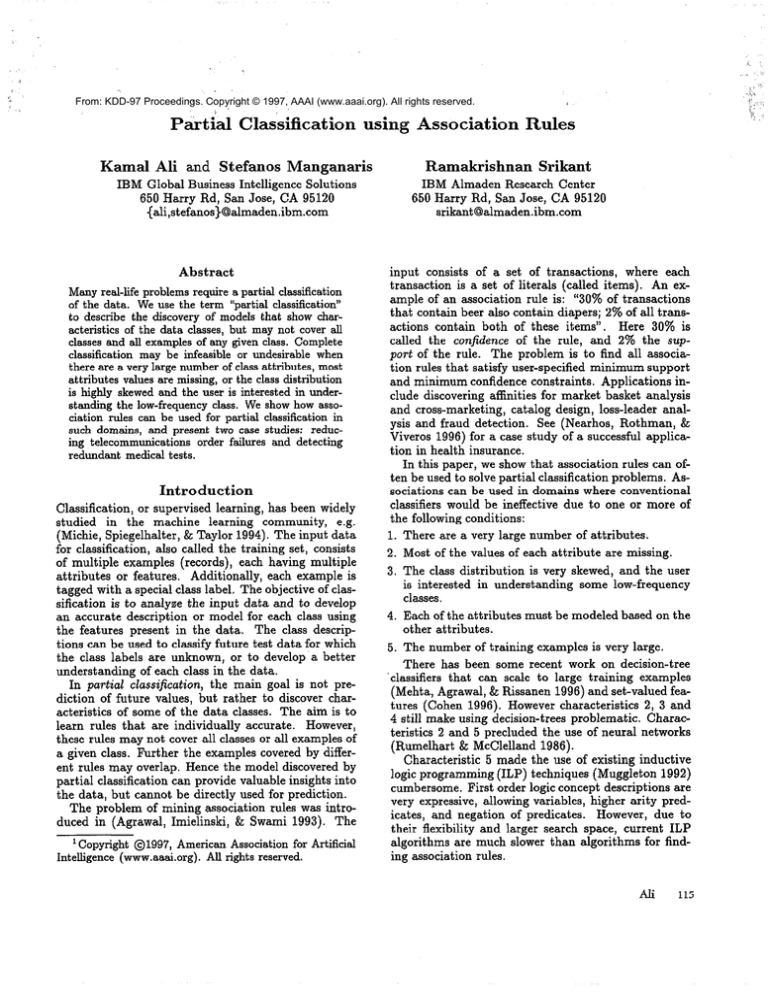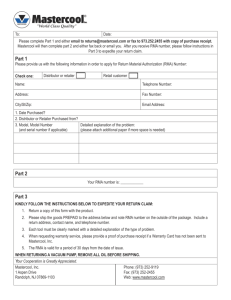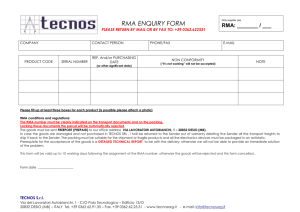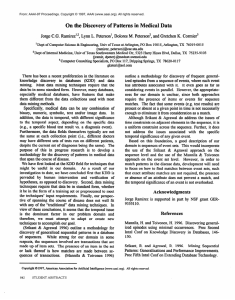
,
From: KDD-97 Proceedings. Copyright © 1997, AAAI (www.aaai.org). All rights reserved.
,.
P&al
Kamal
A li
C lassification
a n d S te fa n o s
Manganaris
IB M G lobal Business Intelligence Solutions
6 5 0 Harry Rd, S a n Jose, C A 9 5 1 2 0
{ali,stefanos)Qalmaden,ibm.com
Abstract
M a n y real-life p r o b l e m s require a partial classification
of the data. W e u s e the term “partial classification”
to describe the discovery of m o d e l s that s h o w characteristics of the d a t a classes, but m a y not cover all
classes a n d all e x a m p l e s of a n y given class. C o m p l e t e
classification m a y b e infeasible or undesirable w h e n
t h e r e a r e a very l a r g e n u m b e r of class attributes,
most
attributes values a r e missing, or the class distribution
is highly s k e w e d a n d the user is interested in u n d e r standing the iow-frequency ciass. - W e s h o w h o w association rules c a n b e u s e d for partial classification in
such domains, a n d present two case studies: reducing telecommunications o r d e r failures a n d detecting
r e d u n d a n t medical tests.
In troduction
Classification, or supervised learning, h a s b e e n widely
studied in the m a c h i n e learning community,
e.g.
(Michie, S p ie g e lh a It er, & Taylor 1994). T h e input data
for classification, also called the training set, consists
of multiple e x a m p l e s (records), e a c h having multiple
attributes or features. Additionally,
e a c h e x a m p l e is
t a g g e d with a special class label. T h e objective of classification is to analyze the input data a n d to d e v e l o p
a n accurate description or m o d e l for e a c h class using
the features present in the data. T h e class descriptions c a n b e u s e d to classify future test data for which
the class labels a r e u n k n o w n , or to d e v e l o p a better
understanding of e a c h class in the data.
In partial class$cation, the m a i n g o a l is not prediction of future values, but rather to discover characteristics of s o m e of the data classes. T h e a i m is to
learn rules that a r e individually accurate. However,
these rules m a y not cover all classes or all e x a m p l e s of
a given class. Further the e x a m p l e s covered by different rules m a y overlap. H e n c e the m o d e l discovered by
partial classification c a n provide valuable insights into
the data, but cannot b e directly u s e d for prediction.
T h e p r o b l e m of mining association rules w a s introd u c e d in (Agrawal, Imielinski, & S w a m i 1993). T h e
’ Copyright 0 1 9 9 7 , A m e r i c a n Association for Artificial
Intelligence (www.aaai.org). All rights reserved.
u s i n g A ssociatio n
Ramakrishnan
R u les
S rikant
IB M A l m a d e n R e s e a r c h Center
6 5 0 Harry Rd, S a n Jose, C A 9 5 1 2 0
srikantQalmaden.ibm.com
input consists of a set of transactions, w h e r e e a c h
transaction is a set of literals (called items). A n exa m p l e of a n association rule is: “3 0 % of transactions
that contain b e e r also contain diapers; 2 % of all transactions contain both of these items”.
H e r e 3 0 % is
called the confidence of the rule, a n d 2 % the support of the rule. T h e p r o b l e m is to find all association rules that satisfy user-specified m i n i m u m support
a n d m i n i m u m confidence constraints. Applications include discovering affinities for market basket analysis
a n d cross-marketing, catalog design, loss-leader analysis a n d fraud detection. S e e (Nearhos, Rothman, &
Viveros 1 9 9 6 ) for a case study of a successful applice
tion in health insurance.
In this paper, w e s h o w that association rules c a n often b e u s e d to solve partial classification problems. Associations c a n b e u s e d in d o m a i n s w h e r e conventional
classifiers w o u l d b e ineffective d u e to o n e or m o r e of
the following conditions:
1. T h e r e a r e a very large n u m b e r of attributes.
2. Most of the values of e a c h attribute a r e missing.
3. T h e class distribution is very skewed, a n d the user
is interested in understanding s o m e low-frequency
classes.
4. E a c h of the attributes must b e m o d e l e d b a s e d o n the
other attributes.
5. T h e n u m b e r of training e x a m p l e s is very large.
T h e r e h a s b e e n s o m e recent work o n decision-tree
‘classifiers that c a n scale to large training e x a m p l e s
(Mehta, Agrawal, & Rissanen 1 9 9 6 ) a n d set-valued features ( C o h e n 1996). H o w e v e r characteristics 2, 3 a n d
4 still m a k e using decision-trees problematic. Characteristics 2 a n d 5 p r e c l u d e d the u s e of n e u r a l networks
(Rumelhart & McClelland 1986).
Characteristic 5 m a d e the u s e of existing inductive
logic p r o g r a m m i n g (ILP j techniques ( M u g g l e t o n i 9 9 2 j
c u m b e r s o m e . First o r d e r logic concept descriptions a r e
very expressive, allowing variables, h i g h e r arity p r e d icates, a n d negation of predicates.
However, d u e to
their flexibility a n d larger search space, current ILP
algorithms a r e m u c h slower than algorithms for finding association rules.
Ali
115
We illustrate
this application
of associations with
two case studies.
The first project was in the telecommunications
domain. The data consisted of around a million orders
(examples), a few (2.5%) of which had failed. Each
order had multiple
sub-parts (attributes),
but fewer
than 1% of the possible sub-parts were present in any
specific order. Thus most attribute values were “missing”. The client was interested in rules characterizing
the failure classes.
The second project was in the medical domain. The
data consisted of medical tests (attributes)
given to patients (examples).
As before, there were hundreds of
medical tests but only a few of them were given to any
single patient. The goal was to see if any of the medical
test results could be predicted by combinations of other
test results. If such tests were found, they could potentially be used to avoid giving patients redundant tests,
or complex/expensive
tests could be replaced with simpler/cheaper
tests. Thus each attribute value is a class
that must be predicted by the other attributes.
Paper
Organization
We give a brief overview of
association rules and frequent itemsets. Next, we describe the telecommunications
and medical diagnosis
---^ sbuum3
A...J:-- iii* d&d.
lx-..I,..
-.----:-^
^.._ -^
J?llltl.lljf, ___^
WC: sullll,lallmz
“UI
I=~abt:
sults and conclude
with a discussion
Association
Rules
of future
work.
Overview
. , /ml be a set of literals, called items.
LetZ=(li,ls,..
Let 2, be a set of transactions, where each transaction
T is a set of items such that T C Z. We say that a
transaction T contains X, a set of some items in Z, if
X C T. An association rule is an implication
of the
form X 3 Y, where X c Z, Y c Z, and X n Y = 0.
The rule X j Y holds in the transaction set V with
confidence c if c% of transactions in 2) that contain X
also contain Y. The rule X + Y has support s in the
transaction
set 2) if s% of transactions
in ?) contain
X U Y. Given a set of transactions V, the problem of
mining association rules is to generate all association
rules that have support and confidence greater than the
user-specified
minimum
support and minimum confidence respectively.
The problem of mining association rules is decomposed into two subproblems:
Find all combinations
of items that have transaction
support above minimum support. Call those combinations frequent itemsets.
Use the frequent itemsets to generate the desired
rules. The general idea is that if, say, ABCD
and
AB are frequent itemsets, then we can determine if
the rule AB + CD holds by computing the ratio r =
support (ABCD)/support
(AB) . The rule holds only
if T 2 minimum confidence. Note that the rule will
have minimum support because ABCD is frequent.
Figure 1 shows an example, assuming a minimum support of 50% (2 transactions) and a minimumconfidence
116
KDD-97
I
Transaction
1
2
3
4
Dataset
ID 1 Items
1 Shoes, Shirt, Jacket
Shoes, Jacket
Shoes, Jeans
1 Shirt ,. Sweatshirt
Fkecluent
Frequent Itemset
Shoes j Jacket
Jacket =+ Shoes
Figure
Itemsets
Rules
Support
50%
50%
1: Association
I
Confidence
66.6%
100%
Rules Example
of 50%. The first step is responsible for most of the
computation
time, and has been the focus of considerable work on developing fast algorithms, e.g. (Agrawal
et al. 1996) (Brin et al. 1997).
Telecommunications
Case Study
This case study focuses on one of the first components
of a process re-engineering
project. A typical service
order for telecommunications
related products undergoes a series of processing steps from entry to completion. Occasionally, a service order falls out of the path
of normal processing, for unanticipated
reasons, with
a request for manual assistance (RMA). Automated
processing for an order that has fallen out cannot continue until one has addressed the exception and put
the order back into the system. The cost of fall-out for
our client was significant, in terms of man-hours
for
handling orders on a case by case basis and in terms
of reduced system throughput
reflecting badly on customer satisfaction.
A service order was described by the set of product
elements it involved, or Universal Service Order Codes
(USOCs), in the telecommunications
lingo. USOCs are
low level components, which can be thought of as basic
hardware or software resources; for example, there is
a USOC for the “call-waiting”
feature on a residential
telephone line. In addition, each USOC in an order was
associated with an action: a resource could be added
or removed.
The goal of this project was to reduce fall-out, by
m-odifvine
to
reasons
._ eliminate
___-----_--_ the
.--- ___
~---. the
_-- nrocess
r----..----- caus_--.ing it. Domain experts suspected that certain combinations of product elements in a service order were
associated with requests for manual assistance. This
case study presents our approach in identifying
the
root causes of fall-out.
In data mining terms, the problem can be cast as
a partial classification
problem:
given historical data
We had
on fall-out,
induce rules that predict it.
more than a million examples of orders with associated
RMA codes that indicated whether processing completed with or without a fall-out incident.
Since an
order may fall-out with different kinds of requests for
manual assistance, we had a multi-class partial classification problem. There were two interesting challenges
in our work: (i) instances were described in terms of a
varying number of attributes, (ii) the prior probability
of fall-out was much lower than that of normal processing. An order involved anywhere from one to 40
USOCs with an average of 3.5 USOCs, out of a set of
several thousand possible USOCs. The prior probability of fall-out, regardless of type of RMA, was about
2.5%; there were about 25 different RMA codes in our
study, with varying frequencies of occurrence.
Our approach involved two steps of analysis.
In
the first step, we identified frequent combinations
of
USOCs for each type of fall-out. We used the association discovery algorithm
to analyze each RMA (i.e.,
each class) separately. For each type of RMA, the outcome was the set of all combinations
of USOCs that
appeared together in a service order with frequency exceed_inu 0 R.
rnigi~-l~m
- ----
ihre&&
(fwn~ren.n.t
\J
. -= --. _- it.em..wtn\
-_-. .“1_“_,
. This
threshold was chosen based on recommendations
from
the domain experts. In the second step, we contrasted
the patterns discovered for each RMA with those expected for service orders that either did not fall out or
fell out with a different RMA. The purpose of this step
was to eliminate patterns that were not predictive even
though they were frequent. To this end, we looked for
a statistically
significant correlation between the presence of each pattern and the RMA class (for which the
pattern was found), using a chi-square test of association. When a pattern was found to be significantly
correlated, we estimated its relative risk,
T = P(fall-outlpresence
P(fall-outlabsence
of USOC combination)
of USOC combination)
’
and its 95% confidence interval.
Figure 2 shows an example of a service order, which
fell-out with RMA code LOOO,involving the addition of
USOCs RJllC and IFR and the removal of BSX. Note,
the completion
status of the order is implicit:
orders
in different classes were kept in separate files. After
examining all orders in class LOOO, we found the following frequent item sets: [BSX : DELI , CRJI IC : ADD] ,
and [BSX: DEL, RJIIC : ADD]. After testing the association of each itemset with RMA LOOO, taking into
account all orders, only [BSX:DEL, RJIlC:ADD] was
found significant:
CBSX:DEL,
RJIIC:ADD]
-+ ~000, with ,=
25,
indicating
that order that include a removal of BSX
and simultaneous addition of RJllC are 25 times more
likely to fail with RMA LOO0 than orders that do not.
Similar rules in our study pointed to an overhaul of
Order ID
0001
Figure
USOC:ACTION
1 RJlIC:ADD
2: File of Service Order
in Class LOO0
the processing mechanisms for handling ISDN-related
orders.
An alternative
approach would be to include the
class of a service order in the “transaction”
as another
attribute,
and find association rules over the whole
data. We would then compute for each rule, A + C,
the relative risk as
W I4
T = P(+A)
= (sup(C)
sup@ A A)lsup(A)
- sup(C A A))/(1 - sup(A)) '
The subset of rules with an RMA as the consequent
and high relative-risk
values, would be roughly the
same set of rules that was found with the first approach. To ensure that the the low-frequency
classes
are represented in the result, one is forced to use extremely low minimum-support
thresholds.
Thus, it
L,,
^-^^ ruywbaub
: __^_ &..-I 4.z-r ^__^ d.- iii* th? diSCOW3i;ji ducxm~um
cu ubcg~-dbc
gorithm a constraint
that we are only interested in
rules that contain an RMA. Without
such integrated
constraints, the huge search space makes selection via
post-filtering
impractical.
Recent work integrating
item constraints into the association discovery algorithm (Srikant, Vu, & Agrawal 1997), enabled us to
test this approach and verify that we got similar results.
Medical
Diagnosis
Case Study
In this proof-of-concept
project, the Information
Services department
of a hospital cleaned the data and
prepared two flat files for mining.
The first file contained demographic measurements of the patients in a
conventional format: one row per patient, one column
per demographic
variable.
Approximately
20 demographic variables were used. The second file resembled
transaction data: the first column consisted of the patient’s visit identification
number, the second column
contained a medical test identifier and the third column contained the outcome of the test. Possible values for the outcome were low, normal and high. This
format was used since the total number of tests per
patient varied from patient to patient.
We had data
on a few thousand patients and there were about 600
medical tests. The doctors had several goals: (1) to
~~~ 1 1 LlI ~~~~ of a medical test in terms of other
moael
me outcome
tests, (2) to see what kinds of tests were “prescribed”
together, and (3) t o see what kind of demographics
were associated with medical tests that were given.
The data was processed to create a combined file
in “transaction
format” with two columns:
the visit
ID of the patient was in the first column and the
Ali
117
Visit ID
001
001
001
001
001
001
.. .
Figure
Tests/Demographics
gender:male
age:fXties
blood-pressure-testmormal
blood-pressure-test
blood-sugar-test:hypoglycemic
blood-sugar-test
..,
3: Combined
Medical
Data
second column consisted of concatenated
symbols of
the form <medical-test>:<outcome>
such as “bloodpressure:low”.
We also created additional records indicating that a certain test had been given without indicating the result of the test. This would enable discovery of associations between kinds of tests given without regard to their outcomes and thus achieve goal (3)
above. Finally, the demographic
information,
such as
“gender:male”,
was added to the transactions.
We discretized each continuous variable into intervals in consultation with the domain experts. Altogether,
then,
the data for visit ID might look as shown in Figure 3.
Including medical test data and demographic
data together allowed for the learning of interplay between
demographics
and types of tests given and their outcomes.
The associations algorithm was applied to this data
and we experimented
with various levels of support and
confidence. We discovered several rules that were new
to the doctors, including an almost perfect model for
one medical test that would allow the elimination
of
that test.
Conclusions
Complete classification
is often infeasible or undesirable when there are a very large number of classes,
most attributes
values are missing, or the class distribution
is highly skewed and the user is interested
in understanding
the low-frequency
class. We showed
how association rules can be used for partial classification in such domains, and illustrated
this application
with two case studies. The goal of the first study was
reducing order failures in the telecommunications
domain. Our results indicated an overhaul of the processing mechanism for handling ISDN-related
orders. The
goal of the second case study was to detect redundant
tests during medical diagnosis. We discovered several
rules that were new to the doctors, including an almost perfect model for one medical test that allowed
the elimination
of that test.
hiure
-work
‘The successfui use of associations for
partial classification poses an intriguing
question: can
associations be used for complete classification?
One
approach to building a classifier on top of associations
would be to add machinery for [‘conflict resolution”
(Ali 1995). Let Rj be the set of rules for class j. The
goal would be to combine evidence among the rules of
118
KDD-97
Rj that fire for some test example z to come up with a
posterior probability
for class j. Then, whichever class
had the highest posterior probability
would ‘Lwin”--z
would be assigned to the winning class.
References
Agrawal, R.; Mannila, H.; Srikant, R.; Toivonen, H.;
and Verkamo, A. I. 1996. Fast Discovery of Association Rules. In Fayyad, U. M.; Piatetsky-Shapiro,
G.; Smyth, P.; and Uthurusamy, R., eds., Advances in
Knowledge Discovery and Data Mining. AAAI/MIT
Press. chapter 12, 307-328.
Agrawal, R.; Imielinski,
T.; and Swami, A. 1993.
Mining association rules between sets of items in large
databases, In Proc. of the ACM SIGMOD Conference
on Management
of Data, 207-216.
Ali, K. 1995. A comparison of methods for learning
and combining evidence from multiple models. Technical Report UC1 TR #95-47, University of California, Irvine, Dept. of Information
and Computer
Sciences.
Brin, S.; Motwani, R.; Ullman, J. D.; and Tsur, S.
1997. Dynamic itemset counting and implication
rules
CA..
L"I ,.,"lrac
111aJ.R.z"
l..r."lm.c
,I-+.,
LJaURGkl Uaa"QI.
In
Pmc
.
-4
“J
CT.,
APIIli
‘#Oz: .rl”l”l
CTfl
IILLS-
MOD Conference on Management
of Data.
Cohen, W. W. 1996. Learning trees and rules with
set-valued features. In Proc. of the 13th National Conference on Artificial
Intelligence
(AAAI).
Mehta, M.; Agrawal, R.; and Rissanen, J. 1996. SLIQ:
A fast scalable classifier for data mining.
In Proc.
of the Fifth Int’l Conference on Extending Database
Technology (EDBT).
Michie, D.; Spiegelhalter,
D. J.; and Taylor, C. C.
1994. Machine Learning, Neural and Statistical Classification.
Ellis Horwood.
Muggleton,
S., ed. 1992. Inductive Logic Programming. Academic Press.
Nearhos, J.; Rothman,
M.; and Viveros, M. 1996.
Applying
data mining techniques to a health insurance information
system. In PTOC. of the 2Zn.d Int’l
Conference on Very Large Databases.
Rumelhart,
D., and McClelland,
J. 1986. Parallel
Distributed
Processing:
Exploration
in
the
Mi-
crostructure of Cognition. MIT Press.
Srikant, R.; Vu, Q.; and Agrawal, R. 1997. Mining
Association Rules with Item Constraints.
In Proc. of
the 3rd Int’l Conference on Knowledge Discovery in
Databases and Data Mining.






